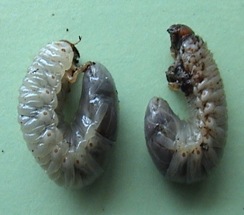White Grub/ Cockchafer Beetle: Leucopholis coneophora
These cream colored grubs are found in abundance in sandy loam tracts of Kerala and Karnataka, especially in Sep – Oct and the beetles emerge in May-June.
Symptoms of Damage:
- In nursery the grubs feet the tender roots and tunnel into the bole of the collar region resulting in drying and yellowing
- In older plantations infestations results in yellowing of leaves, premature nut shedding, delayed flowering, retardation in growth and yield decline.
- White grubs are exposed when base of tree dug
- Tuber crops grown as intercrops are also affected.
Identification of the Pest:
 |
 |
| Grub |
Adult |
- Egg: Oval in shape and creamy white in color when freshly laid. Prior to hatching they turn to dirty white.
- Grub: Curved, fleshy and wrinkled. They are creamy white in color with brown head.
- Adult: Brown coloured beetle with striated wings not covering the abdomen fully
Management:
Cultural Method:
- Repeated ploughing once a week for 4 to 5 times after first rains in summer reduce the pest population by exposing the pest to predation by birds and other animals.
- Plant neem twigs with leaves in coconut gardens after rain to attract and kill adult beetles
- Plough or dig the infested soil synchronizing with pre-monsoon showers.
Mechanical Method:
- Set up light trap @ 1 / ha or bonfire
Chemical Method:
- Soil application - Malathion 5 D 25 kg/ ha at the time of planting (Treat the soil with phorate 10G @ 100 g/palm or drench with chlorpyrifos 0.04% suspension. The treatment should be given twice, first during April-May after the receipt of pre-monsoon showers and second during the month of September - Recommended by KAU).
Physical Method:
- Collect and destroy the adult beetles attracted to trees like neem, Ailanthus and Acasia on the receipt of monsoon showers (in the evening).


